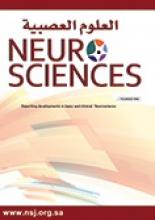Research ArticleOriginal Article
Open Access
Examination of the effects of coordination and balance problems on gait in ataxic multiple sclerosis patients
Fatma Erdeo, Yeliz Salci, Ulvi Uca Ali and Kadriye Armutlu
Neurosciences Journal October 2019, 24 (4) 269-277; DOI: https://doi.org/10.17712/nsj.2019.4.20190038
Fatma Erdeo
From the Department of Physiotherapy (Erdeo), Department of Neurology (Uca), Faculty of Health Science, Necmettin Erbakan University, Konya, and from Faculty of Physical Therapy and Rehabilitation (Salcı), Hacettepe University, Ankara, Turkey.
Pt, PhdYeliz Salci
From the Department of Physiotherapy (Erdeo), Department of Neurology (Uca), Faculty of Health Science, Necmettin Erbakan University, Konya, and from Faculty of Physical Therapy and Rehabilitation (Salcı), Hacettepe University, Ankara, Turkey.
Pt, PhdUlvi Uca Ali
From the Department of Physiotherapy (Erdeo), Department of Neurology (Uca), Faculty of Health Science, Necmettin Erbakan University, Konya, and from Faculty of Physical Therapy and Rehabilitation (Salcı), Hacettepe University, Ankara, Turkey.
MD, PhdKadriye Armutlu
From the Department of Physiotherapy (Erdeo), Department of Neurology (Uca), Faculty of Health Science, Necmettin Erbakan University, Konya, and from Faculty of Physical Therapy and Rehabilitation (Salcı), Hacettepe University, Ankara, Turkey.
PhD, Prof
References
- ↵
- Jacques FH,
- Lublin FD
- ↵
- Wilkins A
- ↵
- Bastian AJ
- ↵
- Diener HC,
- Dichgans J,
- Bacher M,
- Gompf B
- ↵
- Horak FB,
- Diener HC
- ↵
- Earhart GM,
- Bastian AJ
- ↵
- Palliyath S,
- Hallett M,
- Thomas SL,
- Lebiedowska MK
- ↵
- Keklicek H,
- Cetin B,
- Salci Y,
- Balkan AF,
- Altinkaynak U,
- Armutlu K
- ↵
- Morton SM,
- Bastian AJ
- ↵
- Morton SM,
- Bastian AJ
- ↵
- Ilg W,
- Golla H,
- Thier P,
- Giese MA
- ↵
- Kurtzke JF
- ↵
- Salci Y,
- Fil A,
- Keklicek H,
- Çetin B,
- Armutlu K,
- Dolgun A,
- et al.
- ↵
- Schmitz-Hübsch T,
- du Montcel ST,
- Baliko L,
- Berciano J,
- Boesch S,
- Depondt C,
- et al.
- ↵
- López-Rodríguez S,
- Fernández de-Las-Peñas C,
- Alburquerque-Sendín F,
- Rodríguez-Blanco C,
- Palomeque-del-Cerro L
- ↵
- Duncan PW,
- Weiner DK,
- Chandler J,
- Studenski S
- ↵
- Yazici M,
- Livanelioglu A,
- Gucuyener K,
- Tekin L,
- Sumer E,
- Yakut Y
- ↵
- Forsberg A,
- Andreasson M,
- Nilsagård YE
- ↵
- McConvey J,
- Bennett SE
- ↵
- Faul F,
- Erdfelder E,
- Lang AG,
- Buchner A
- ↵
- Hayran M
- ↵
- Green SB,
- Salkind NJ
- ↵
- Givon U,
- Zeilig G,
- Achiron A
- Sosnoff JJ,
- Weikert M,
- Dlugonski D,
- Smith DC,
- Motl RW
- ↵
- Chung LH,
- Remelius JG,
- Van Emmerik RE,
- Kent-Braun JA
- ↵
- Benedetti MG,
- Piperno R,
- Simoncini L,
- Bonato P,
- Tonini A,
- Giannini S
- Thoumie P,
- Lamotte D,
- Cantalloube S,
- Faucher M,
- Amarenco G
- ↵
- Morris ME,
- Cantwell C,
- Vowels L,
- Dodd K
- ↵
- Martin CL,
- Phillips BA,
- Kilpatrick TJ,
- Butzkueven H,
- Tubridy N,
- McDonald E,
- et al.
- ↵
- Kernozek TW,
- Ricard MD
- ↵
- Charlett A,
- Weller C,
- Purkiss AG,
- Dobbs SM,
- Dobbs RJ
- ↵
- Aguiar L,
- Santos-Rocha R,
- Vieira F,
- Branco M,
- Andrade C,
- Veloso A
- ↵
- Galli M,
- Cimolin V,
- Rigoldi C,
- Pau M,
- Costici P,
- Albertini G
- ↵
- Pau M,
- Coghe G,
- Corona F,
- Marrosu MG,
- Cocco E
- ↵
- Courtemanche R,
- Teasdale N,
- Boucher P,
- Fleury M,
- Lajoie Y,
- Bard C
- ↵
- Meyring S,
- Diehl RR,
- Milani TL,
- Hennig EM,
- Berlit P
- ↵
- Abdurakhmanov MA,
- Stoliarov ID,
- Il’vesa AG,
- Tsvetkova TL,
- Lebedev VV
- ↵
- Rao SM
- ↵
- Shumway-Cook A,
- Woollacott HM
In this issue
Neurosciences Journal
Vol. 24, Issue 4
1 Oct 2019
Examination of the effects of coordination and balance problems on gait in ataxic multiple sclerosis patients
Fatma Erdeo, Yeliz Salci, Ulvi Uca Ali, Kadriye Armutlu
Neurosciences Journal Oct 2019, 24 (4) 269-277; DOI: 10.17712/nsj.2019.4.20190038
Jump to section
Related Articles
- No related articles found.
Cited By...
- No citing articles found.





